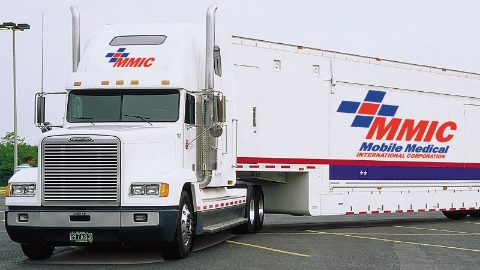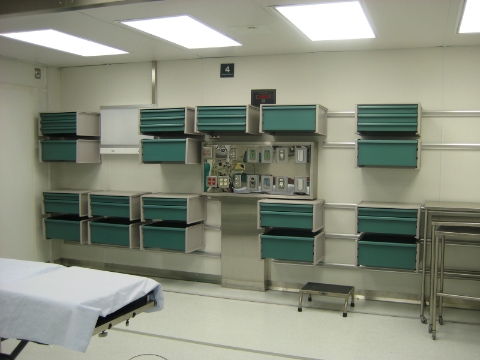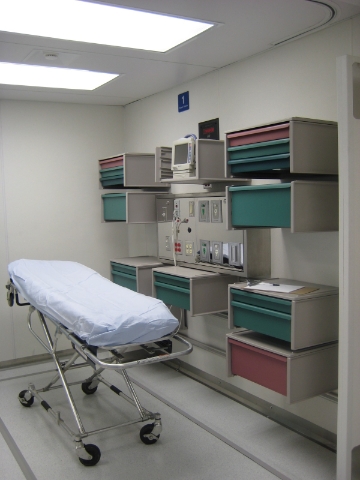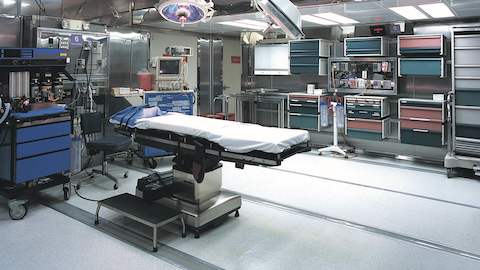Mobile Medical International
Providing durability on the go
Saint Johnsbury, Vermont, US
Download PDF (381.1 KB)
In 1994 while working as a consultant in the healthcare field, Rick Cochran had an idea about providing services to rural or underserved areas: Why not create fully-equipped mobile health care units that could move from place to place serving the needs of different communities?
That was the start of what became the industry's first Mobile Surgery Unit (MSU). Today Cochran's company, Mobile Medical International Corporation (MMIC), provides fully equipped MSUs to communities all over the world, from the Kingdom of Saudi Arabia to Honolulu, Hawaii.
Each MSU is a custom-designed semi-truck trailer that expands to more than 1,000 square feet, serving a variety of needs. Hospitals undergoing renovations use them as temporary operating rooms so they don't have to shut down services; surgeries are performed as usual, with no disruption to patient flow or volume, maintaining a constant revenue stream.

They're also ideal for disaster areas and war zones needing immediate care facilities; MSUs are currently in Iraq and three were mobilized in Texas following Hurricane Ike.
There's one at a prison in North Carolina and at an Indian reservation in Arizona. Rural communities needing services, such as diagnostics and mammographies, are also served. In addition, there are laboratory, pharmacy, dental, ophthalmology, and endoscopy units that can be moved wherever they're needed—either temporarily or semi-permanently.
Because of the nature of their work, it is imperative that these mobile units be not only completely self-contained and durable, but also adaptable and flexible enough to meet the diverse demands of clients. Hospital staff using mobile surgical units, for example, must be able to quickly and easily switch equipment and supplies to accommodate different types of operations being performed.
Since the first unit was introduced in 1996, MMIC has depended on the Herman Miller Co/Struc modular line, known for its durability and flexibility, meeting their many storage needs.
The name Co/Struc is derived from "coherent structures;" the system is designed to support customized arrangements of storage, dispensing, material handling, and surface components. Components securely affix to the MSU's walls, where they can remain during transport. Once on site, the cabinets and storage drawers are designed for maximum flexibility, so staff can easily add, remove, or reconfigure pieces without tools.

Co/Struc modular storage components attach to the MSU walls.
Bins and cabinets are affixed to a rail on the wall and a foot pedal raises or lowers the units as needed. The Co/Struc product offering serves a broad range of functions, too, including lab benches, casework, endoscopy storage, and pharmacy pick-up stations. Because it can be assembled, moved, and reconfigured easily for many different work settings, Co/Struc can be used virtually anywhere in a healthcare facility. This maximizes efficiency, maintains sanitary conditions and saves labor.
"Co-Struc works very well in a mobile environment," says Janet Lumbra, Senior Business Development Manager at MMIC. "It's extremely durable and the drawers and cabinets come in a variety of sizes so they can be used for anything from cleaning supplies to surgical instruments.
"Because they're on wheels, the storage units can easily be moved in, out and around areas," she continues. "Hospital staff can stock what they need for a particular surgery in an off-area, roll the units into the operating room and roll them back out to restock for the next operation."
In addition, the Co/Struc C-Lockers have locks, which eliminate security issues.
"We have an MSU configured as a Mobile Endoscopy Unit at a VA Hospital in West Virginia that has Co/Struc C-lockers," says Ms. Lumbra. "They keep two of them fully stocked, roll them out and replace the ones used the previous day and restock those for the next day. These faster turnovers make everything more productive and efficient for the staff.
"Another thing hospitals like is that they can color code the drawers for certain things, allowing them to quickly find what they need at a glance," continues Lumbra. "So we work hard to provide them with a variety of colors and sizes."

Designed for maximum flexibility, Co/Struc components can be easily reconfigured without using tools.
Ms. Lumbra says the Herman Miller name, too, has served them well over the years. "Hospitals are familiar with Herman Miller because they use their products in other areas of the hospital. They know the quality, which is a good selling point for us. Our mobile units are state-of-the-art and we want them to be equipped with the best products manufactured by high-end, well-known, reliable companies."
In fact, much like the MSUs, the Co/Struc system was also created to serve a need. Its designer, Robert Propst, while having back surgery in the 1970s, noted that hospital storage and transport cabinets were cumbersome and inefficient. Co/Struc, introduced by Herman Miller in 1974, was his solution.
Today, Co/Struc and MMIC provide healthcare solutions to clients throughout the world, making it a healthier, safer and better place to live.
